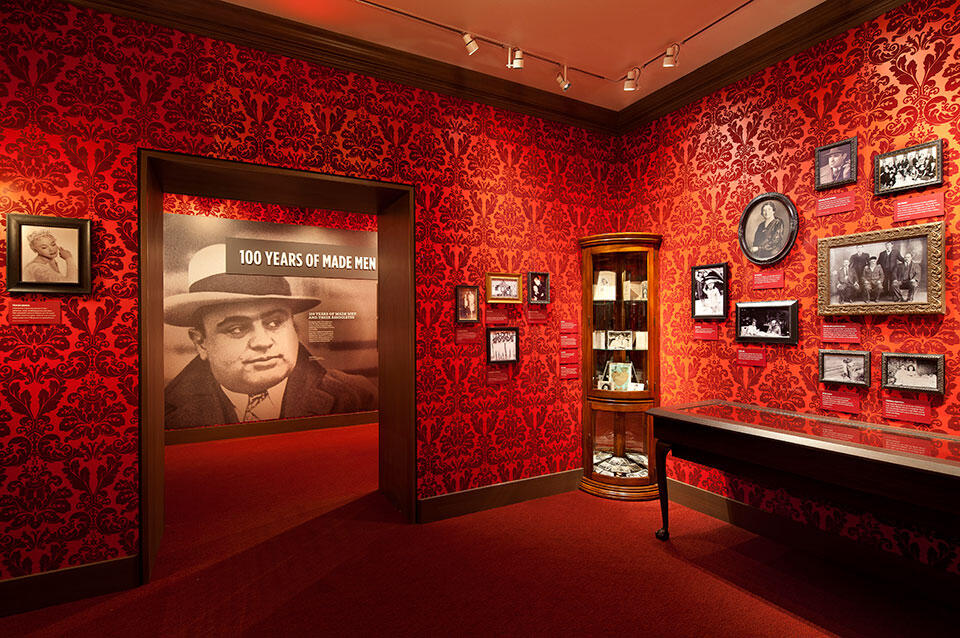Museums don’t just house the past. They tell us stories. Stories that shape our understanding of the yellowing photos, old papers, and antique objects that they contain. When we visit a museum, we’re not just encountering pure facts; we’re walking into a rhetorical space in which we’re persuaded to see things in a particular light.
One of the things that makes museums and other places such powerful forms of remembering is that we, as Americans, find them inherently trustworthy. As historians Roy Rozenzweig and David Thelen discussed in their book The Presence of the Past, Americans saw museums as the most trustworthy source of information about the past — more trustworthy even than history textbooks and, ahem, college professors.
In my University Forum lecture, I’ll illustrate how places become persuasive by discussing the example of our own National Museum of Organized Crime and Law Enforcement — better known as the Mob Museum. As a scholar of rhetorical studies, I examine how people use language persuasively in public. We employ rhetoric any time we use symbols — words, images, architecture, etc. — to try to influence a group of people to take action or to change their attitude or identity. Want to get elected to the school board? Use rhetoric. Need your neighbors to keep their barking dog inside? Use rhetoric.
The Mob Museum can also be thought of as an answer to a set of problems that’s unique to Las Vegas: How do we keep tourists flocking to the attractions of our valley while also providing a sense of pride and cultural resources for the residents? My talk will show how the museum’s layout, exhibits, language, and imagery address what I call “rhetorical problems” presented by the museum’s unique location in a downtown redevelopment area in the world’s tourism capital.
For instance, a key problem that supporters, creators, and promoters of the Mob Museum faced was how to construct an “authentic” and engaging narrative about the Mob without either glorifying the Mob or raising concern that the Mob was still active in Las Vegas. While many of the museum’s exhibits address this problem, one of my favorite examples is the room on the first floor dedicated to the “Memories of the Mob.” This small exhibit features a gallery of antique family photos of weddings, children, and other images emphasizing mobsters’ roles as “family men.”
When I first visited the museum, the exhibit struck me as out of place, as it follows the floor focused on law enforcement’s efforts to bring down the Mob. Yet, when I began to consider it in the context of the broader narrative — that the Mob is a thing of the Las Vegas past — I began to see its rhetorical function: to make it appear that the Mob exists only in black-and-white family photos. Made men no longer live to roam our streets; they appear only in these dusty artifacts. Yet, someone had to unpack the photos from the attic, so we know that the descendants of these families live on. An exhibit using artifacts to show how Mobsters existed as people only in the past suggest that the heirs to these traditions have somehow disappeared. We leave the museum feeling safe and separate from the dangers presented there.
I became interested in the Mob Museum for a few reasons. First, as a local living near downtown, I’ve become invested in the many changes happening around my neighborhood. While I clearly benefit from many of the improvements that downtown redevelopment brings, I’m also cognizant of the problems of gentrification, including higher rent and displaced neighbors. The museum was a centerpiece of these redevelopment efforts, and I wanted to know how its creation was influenced by that debate.
Second, as a UNLV professor, I teach a course called “Rhetoric and Public Memory,” in which students are required to visit and write an analysis of the museum. I quickly discovered that my students had strong opinions about the purpose of the museum. When we discuss their visit in class, there’s often a pretty even split between students who think that the museum glorifies the Mob and those who think that it condemns the Mob. I wondered what, specifically, about the museum invited such varied interpretations.
Third, as someone who researches how we use rhetoric to remember the past, I wanted to investigate exactly how memory works in a young city that’s run by a tourist economy. How does the Mob Museum work both as a place to store historical information and as a tourist attraction? I’m interested in how my community works, and studying the Mob Museum seemed like the perfect opportunity to learn more about that.
Former Mayor Oscar Goodman was a big booster of the Mob Museum. While talking up the museum in 2009, Goodman was reported to have quipped to a local blogger, “nobody’s going to come to downtown Las Vegas to look at paintings. What will they look at? They’ll look at something that’s really embedded in history, that makes us unique and distinctive from any other city, that has a historical nexus, [like] a keystone because of the Kefauver hearings ... And I think it’s a natural.”
Although the museum may seem like a “natural,” someone had to promote it and construct it. Someone (or, more accurately, a bunch of someones) shaped its stories. I want people who encounter those stories about the past to think critically about the stories they’re being told.



